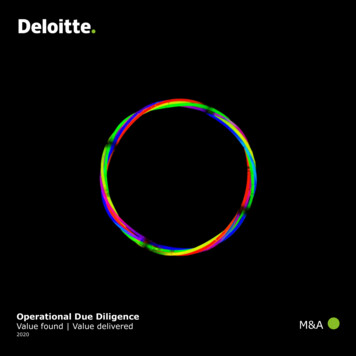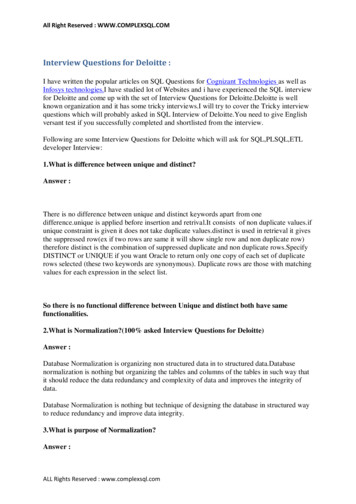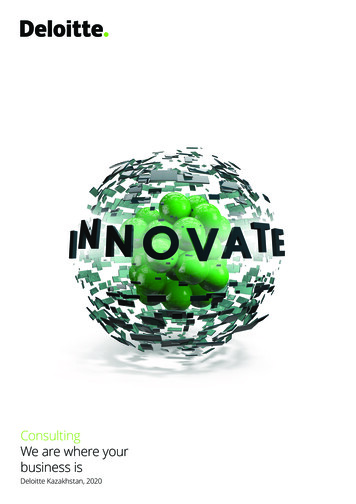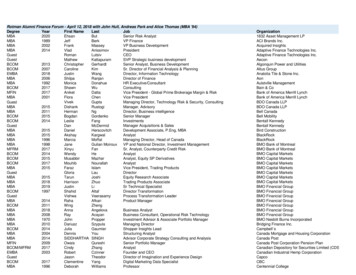
Transcription
Operational Due DiligenceValue found Value delivered2020M&A
WelcomeOn the occasion of my 20th birthday as a M&A professional, and the relative unfamiliarity of Operational Due Diligenceas a profession, I have taken the opportunity to summarize the role of operational expertise in M&A processes.The executive summary on the next page provides my definition of Operational Due Diligence. This definition goesbeyond the first connotation most deal professionals have. To fully utilize the benefits of Operational Due Diligence invalue creation planning, deciding on the right deal, and delivering the deal value, I believe a comprehensivedescription will be instrumental to a more effective use of operational expertise in value creation through M&A.This thesis is written on a personal title, however my vision has been inspired by the clients and colleagues I havebeen working with over the last two decades. My corporate clients taught me how to build buy-in for change, and tosee deals through the eyes of corporate transformations. My private equity clients continuously show me dealdiscipline and cash focus. And my colleagues inspired me to further codify the work we do, and to maintain a highstandard of quality.In order to explain Operational Due Diligence’s essence, I compare it to more common types of Due Diligence, suchas Financial, Legal, and Tax Due Diligence. I believe this comparison helps to see how Operational Due Diligence cancontribute to an enhanced understanding of the company for sale, and the way our clients can create value throughM&A. My comparison is not a better or worse qualification. I truly believe that every deal has its own deal risks andprocess challenges, and therefore requires a tailored due diligence investigation to successfully proceed in the dealprocess, and to deliver the deal value.I hope this publication contributes to an effective, value creation based, dialogue with the Transaction Serviceprofessionals mentioned on page 41.Jasper de GrauwTransaction Services 31-(6) 5207 8787 2020 Deloitte The Netherlands3
ContentsExecutive summary61. Main objectives of Operational Due Diligence92. How companies create value through M&A133. How to strike a balance between risks and opportunities194. How does Operational Due Diligence fit into overall M&A process235. Breadth and depth of Operational Due Diligence276. Roles and ownership317. How to perform Operational Due Diligence35 2020 Deloitte The Netherlands5
Executive summary6 2020 Deloitte The Netherlands
Executive summaryOperational Due Diligence is a bespoke, continuous and iterative process of formulatingand testing the investment thesis, in order to co-create an actionable value creationplan. Operational Due Diligence is primarily forward looking and opportunity focused, ittherefore complements the risk oriented types of due diligence to maximize the returnon M&A investments.Some key words in the above definition need furtherelaboration:The primary objective of an Operational Due Diligence(ODD) is to provide input to the value creation plan. Thescope of an ODD is therefore by definition bespoke aseach deal is unique. The scope will be tailored to the dealrationale, deal structure, industry and company specificoperational risks. There are no standard procedures thatare typically performed in each ODD, whereas the scopeand procedures of a financial due diligence (FDD) or legaldue diligence (LDD) are relatively standard.Developing an effective value creation plan should be aco-creation and cannot be a report from an advisor tothe acquirer. In testing the investment thesis, the ODDteam needs to work closely with the management teamresponsible for implementing the plan post-closing. Aproper value creation plan comprises: a prioritized set of value creation opportunities(synergies and stand-alone performance improvementinitiatives), as well as. a plan for action, describing how to capture the upsidesand to mitigate the execution risks.ODD is a continuous process which does not stop at theend of the due diligence phase. Operational Due Diligenceprocedures start as part of the target selection phase andcontinues throughout the deal cycle, up to and includingthe first 100-days post-closing. Whereas FDD and LDDfindings are key inputs for further negotiation and SPAdrafting, continued processing of ODD findings in thevalue creation plan, as more access is granted, is key tosecure buy-in from both target and divisionalmanagement.Commercial Due Diligence (CDD) assesses theattractiveness of the market the target operates in as wellas the relative strengths of the target today compared toits competitors. Like FDD the as-is assessment of CDDprovides important input for ODD to answer the question“what should we change in our operations to create moreshareholder value?”. The translation of facts into an actionplan is at the heart of ODD and provides its forwardlooking orientation.The iterative character is embedded in the hypothesisbased approach that is applied to ODDs, in answering thequestion “how can we best create value with thecontemplated transaction?”. ODDs start with hypotheses,which are tested and reformulated until they can nolonger be broken down. ODDs facilitate creativity, pull onmultiple information sources and allow for interactionbetween stakeholders. The best results are achieved byan inductive and iterative process, focused on providingactionable insights, which are presented in a conciseequity story.A balanced ODD helps acquirers to look at risks through adifferent lens. When risks are well understood andmanaged, it can be an inspiration for opportunities togrow. Vice versa, when companies pursuit opportunitiesthese will come with risks. Operational Due Diligenceplays a role in seeing both sides of the coin. In the currentcompetitive M&A market deal teams need to strike abalance between issue and risk based due diligencescoping and the identification and substantiation ofupsides. ODD as part of the overall due diligence scopechanges the lens from ‘due diligence to lose’ into ‘duediligence to win’. 2020 Deloitte The Netherlands7
The above definition urges a comparison of ODD with other types of due diligence, such as financial-, tax-, commercial andlegal due diligence, which are focused on describing the existing economic value and on informing the Share PurchaseAgreement (SPA):FDD, CDD, Tax DD,Legal DDODDChapter of this thesisOrientationBackward lookingForward looking1. Main objectives of ODDObjectiveProtect valueCreate value2. How companies create value through M&AFocusRisk focusedOpportunity focused3. How to balance risks and opportunitiesProcessFinished processContinuous process4. How does ODD fit into the M&A processScopeCustomaryBespoke5. Breadth and depth of ODDWhoIndependentCo-creation6. Roles and ownershipHowSequentialIterative7. How to perform a ODDBased on the above description ODD includes: 1) the development of a value creation plan, 2) an un-biased adviseregarding the strategic fit of the transaction, and 3) an essential process step for obtaining buy-in from targetmanagement. The responsibility for conducting a robust ODD lies with the entity integrating or acquiring the targetcompany, but can not be performed without involvement from target management. External ODD advisors can provideadditional specialized expertise and significantly increase the quality of operational analysis. However, they cannotreplace the required ownership.8 2020 Deloitte The Netherlands
1. Main objectives of ODD 2020 Deloitte The Netherlands9
1. Main objectives of Operational Due DiligenceAccording to ‘The Art of Merger and Acquisitions’ (NewYork, 1989), Book by Alexandra Reed Lajoux, “the basicfunction of due diligence is to assess the benefits andliabilities of a proposed acquisition by inquiring into allrelevant aspects of the past, present and predictablefuture of the business to be purchased”.diligence, such as:The term due diligence is used by the M&A industry in abroad sense and can cover financial, legal, operational,commercial, tax, HR, IT, pension and technicalengineering matters. The scope of a due diligenceinvestigation varies, as many internal and externalfactors influence the depth and breadth of a dueInvestment thesisValuation availability of information in the data room existing acquirers knowledge of the target company estimated risks and risk appetite available time for due diligence restrictions in allowed data exchange set by thecompetition authoritiesDue diligence findings are typically used to shape thefollowing deal documents:SPAIntegration planScoping, area, breadth, depth focus ODD focus FDD, LDDLooking backwardFinancial due diligence is an assessment of the currentfinancial position of the business. As such it mightindicate that the business exceeded its sales goals forthe last two years. It would also explain that itaccomplished this due to market improvements orbecause the company’s sales process caused thebusiness to improperly project sales. Financial duediligence is primarily backward looking, provides adetailed assessment of the current situation and inputfor the valuation and price mechanism in the SPA.Legal Due Diligence is performed to assess the legalaspects of the business, by exploring its current legalstatus. It would include any outstanding issues of10 2020 Deloitte The Netherlandsownership, pending legal actions, outstandingjudgments, liabilities, employee actions, insuranceclaims, intellectual property rights, professionallicenses, and so on. Legal due diligence accommodatesdrafting the share purchase agreements (SPA) tosecure the buyer will become the legal owner of whathe believes is put-up for sale and to provide protectionagainst known liabilities.Similarly, tax, HR, IT, pension and technical duediligence are largely focused on looking backward, andunderstanding how the business performs today basedon this backward look.
Looking forwardIdentifying operational weaknesses and risks often providesa good reason for investing. If, for example, you identifythat the business has a weak sales organisation, theinvestment plan could be to put additional funds into thesales organization after the acquisition. If the sales teamonly has regional strength, the merger with an organizationwith a national footprint might release significant value. It isthe ODD task to find the unrecognized potential in abusiness.The focus of ODD procedures is to assess if a business iscapable to sustain its operations into the future, and todescribe actions and investments needed to acceleratebusiness growth. The ODD indicates how a positive returnon the M&A investment can be made.ConclusionsThe objectives of an ODD are to: Assess the sustainability of the target’s operationsinto the future, without additional investment ontop of management’s business plan Identify actions and investments needed, not seenor considered by target management, to acceleratevalue creation moving forward Advise the deal team on the strategic fit of thecontemplated transaction As process, ODD should secure buy-in from allstakeholders for the planned changeWhereas financial, tax, and legal due diligence providethe basis to assess the current economic value andinform the SPA to protect the price paid, ODD is moreforward looking and answering the question “what arewe going to do with it, when it is ours?”. 2020 Deloitte The Netherlands11
ExampleA client became a valuable private company, but publicinvestors were reluctant to invest and its IPO failedresulting in a 85% value impairment for Softbank the mainfinancial sponsor. So what happened?Fundamentally, our client engages in “rent arbitrage” bysigning long-term leases, generally 15 years, at one rateand subleasing the space to SMEs and Enterprise membersat with shorter durations. While the cost per desk is lowerfor the member, the aggregate rent it receives is higher forthe space due to the density. This practice obviously createsa duration mismatch which leaves our client exposed tomarket fluctuations in the event of a downturn. The shortduration of the subleases leaves our client exposed to therisk that tenants might abandon the space on short notice,leaving them liable for the master lease obligation. They arealso exposed to the credit risk of the SME subleases.A significant advantage of our client’s business model is thefact that even though tenants are crammed into smallerspaces, they pay lower costs overall for their spaceservices. The lower rent expense to the tenant is one of thesignificant drivers of their business model.However, the downside to the business model is that it isexpensive. The cost of providing the space services issignificantly higher than those incurred under the traditionaloffice format. There is also the higher cost of the physicalimprovements to the space to provide our clients “look”.Industry estimates indicate that the aggregate has to be inthe range of twice the market rate for the entire subleasedspace to cover the increased operational costs and the noneconomic space of the community areas.So, does the business model make economic sense whencompared to the traditional office market analytics? TheCompany has been losing money at the same rate ofincreasing its top line revenues. Our client has never beenprofitable but its founder (and ex-CEO) points to Amazonand the years it took for them to cross over intoprofitability.12 2020 Deloitte The NetherlandsOur client focusses on different metrics to track theirperformance. The first important metric it tracks is new“membership” (desks rented) growth. This concept is akinto the concept of “eyeballs” or “clicks” tech companies useon the theory that the more views one receives, theincreased probability of a sale. Indeed, its founder hasanalogized the business to a tech company in corporatepresentations due to their extraordinary membershipgrowth.It has been claimed by the company the model is “assetlight” as they are providing a “service” more akin to UBERor Airbnb. With membership growth it believes they willachieve scale and become the dominant global presence inthe co-working space sector. It believes its brand willbecome the default choice for global Enterprises requiringmultiple locations and make the buildings it occupies morevaluable.However, unlike Uber or Airbnb, our client has assets, lotsof them. Its leases are assets, 15 billion and their rentalobligations are liabilities, 18 billion. But these areoffsetting. More importantly, the company has 7 billionof property and equipment. These are the desks, thechairs, the copy machines, the barista equipment, etc.Uber and Airbnb do not have the corporate overhead ourclient does. Uber, in particular, has independent contractordrivers and Airbnb does not own the properties where theyfacilitate rentals. In contrast our client has thousands ofemployees providing numerous services. They haveemployees on-site and at their corporate headquartersdirecting new acquisitions, overseeing the new tenantimprovements, and managing the actual operations at theirfacilities. It is really difficult, and time and employeeintensive, to provide consistent and exemplary service toone’s clients. Ask any hotel manager. While not technically“assets”, their people represent a significant expense notfound in the typical “tech” company.Operational Due Diligence could have revealed the trueeconomics of the business and the flaws in reported kpi’s.Furthermore ODD would have provided investors withguidance regarding a more rational value creation plan.
2. How companies createvalue through M&A 2020 Deloitte The Netherlands13
2. How companies create value through M&AFrom the acquirer’s point of view, a transaction can lead to value creation through:1. Stand-aloneperformanceimprovement2. Realisation ofsynergies betweenthe acquirer and thetarget3. Acquisition of aTarget at a lowerprice than its intrinsicvalue14 2020 Deloitte The Netherlands
1. Stand-alone performance improvementFinancialvalue driversValue generated through stand-alone performanceimprovement initiatives is an avenue typically exploitedby private equity, but which is also applicable tostrategic buyers. Improving the acquired company’sperformance beyond the existing management’sbusiness plan requires a holistic approach, covering allfour financial value drivers of equity value (see graph),as well as finding the balance between short-termactions and long-term value drivers, to secure thecompany’s future.Equity valueNOPLATmarginInvestedcapitalMedium and long-term value creationThe medium to long-term initiatives typically generatesignificant returns, but are more difficult to capture. In orderto secure the organisational health on the long-term themore fundamental changes in the company’s operatingmodel need to be aligned with the long-term strategy.EnhancedpricingCategorymanagementSales e driversGrowth rateShort-term value creationTypical first year of ownership initiatives to improve theperformance of the business and generate access cashto fund more structural improvements are: enhancedpricing and sales force incentives to push the topline,cost base rationalization, improved inventory turns andshorter average DSO as well as re-financing options toreduce the cost of debt. In particular our private equityclients use financial disciplines and proven tooling tosecure these benefits.Short-term Medium-termvalue drivers value Off-shoringTaxefficiencyDigitizationNWC turnAssetutilizationIncreaseleverageCost ofcapitalStrategichealth: (re)definecorebusiness Newproductsnewmarkets Asset lightbusinessmodelsOrganizational healthImproveterms ofdebtDeciding on the sequence of initiatives, as well as the riskprofile, is a key responsibility of the deal team as part of theOperational Due Diligence process. 2020 Deloitte The Netherlands15
2. Realisation of synergies between the acquirer and the targetTo correctly select, price, and integrate acquisitions anunderstanding of the strategic rationale of the plannedacquisition is required. The best way to do that is tothink of the target in terms of customer valueproposition, profit formula, resources and processes.Broadly speaking, there are two strategic reasons tomerge companies. The most common one is to boostthe acquirers current performance in terms ofcapabilities and products, which helps to hold on to apremium position, on the one hand, or to cut costs, onthe other.Under the right circumstances, only resources can beextracted from an acquired company and plugged intothe parent’s business model to boost the acquirersperformance. Resource focused deals are called“leverage my business model” (LBM) acquisitions. Inorder to grow the business, a company can buy anotherfirm’s business model, operate it separately, and use itas a platform for transformative growth. We call that a“reinvent my business model” (RBM) acquisition.The second reason to acquire a company is toaccelerate growth by entering a new market, or to learnfrom the acquired company and reinvent the parentbusiness model (Christensen, 2011). See also the M&Astrategic gameboard below and the two strategicreasons marked in two grades of blue.NewM&A Strategic objectives gameboardExtend Geographic FootprintRBM Enter new geographicmarketsContent For New Segments Acquire requisitetechnologies/capabilitiesMarkets Acquire new products to reach customersin existing geographiesCapture Market Share Maintain market leadership/dominatesegmentBuildon strengths(customer &channelrelationships)Existing Take advantage of fragmented industry toroll-up the tailRBMComplementary Capabilities Gain competencies in keyoperational/technological areas Access to alternative distributionchannels or move forward in the valuechainLBMExistingCapabilities/ProductsDeals which aim to boost the acquirers current performance by cutting costs or hold on premium positionsDeals to accelerate growth by entering new markets or reinvent parents business model16 2020 Deloitte The NetherlandsRBMNew
“Leverage my business model” (LBM) examplesWhen ASML, the lithography machine builder, acquiredHMI, the market leader in wafer inspection technology,it captured nice cross selling synergies, and securedvital technological know-how and the dedication of theHMI engineers for ASML’s continued quest intoproducing more patterns on silicon at nanoscale, tomaintain ASML’s leading market position.The market consolidation strategy the Dutch grocery retailerJumbo embarked on in 2009, by acquiring Super de Boer,and later on C1000 and Emté, demonstrates the power ofM&A in markets where fixed costs are important (forgrocery retailing: store rent, transportation, distributioncentre costs, marketing and branding).“Reinvent my business model” (RBM) exampleOil majors like Shell and Total are considering to enterthe power utility market, to disrupt their existing oilbased business models and to ride the wave ofelectrification.DealtypeLBMRBMStrategic reasonODD Focus areaAcquiring resources to Unicity of technologycommand premiumand ability topricesmaintain critical staffAcquiring resources to Compatibility oflower costresources (input andprocesses)Accelerating growthby entering a newmarketQuality of product andmarket positionagainst peersConclusionsCompanies turn to acquisitions to meet goals theycannot achieve internally. But there is no magic inbuying another company: Companies can do acquisitions that allow them tocommand higher prices, but only in the same waythat they could have raised prices all along, byimproving products that are not yet good enoughfor the majority of their customers Companies can do acquisitions to cut costs by usingexcess capacity in their resources and processes toserve new customers, but again, only in the sameway that they could have by finding new customersor increasing capacity on their own Companies can do acquisitions to acquire newbusiness models to serve as platforms fortransformative growth, which they could havedeveloped in-houseAt the end of the day, the decision to acquire is aquestion of whether it is faster and more economicalto buy something that you could, given enough timeand resources, make yourself. With mergers you buytime. But you only buy time when you are, post deal,able to maintain the know-how, resources or businessmodel the target company is offering. The scope of anODD should therefore focus on assessing if theseresources, know-how or business model exists andcan be maintained post dealFurthermore the scope of an ODD investigation shouldbe geared to test the investment thesis and thereforea deep understanding of how shareholder value can becreated with the envisaged transaction is required.Stand-alone and or via synergies.Acquiring to learn and Unicity of businessreinvent parentmodel and ability tobusiness modelpreserve 2020 Deloitte The Netherlands17
2020 Deloitte The Netherlands18
3. How to strike abalance between risksand opportunities 2020 Deloitte The Netherlands19
3. How to strike a balance between risks and opportunitiesAs discussed in earlier chapters, the objective of thecommon types of due diligence is to protect value andbring deal risks back within an acceptable range. Thiscan be considered a “play not to lose” focus. Based onmany stories of failed mergers, and declining post dealearnings due to uncovered corporate missteps, risks areconsidered a negative that must be managed.Although true, this is just one side of a two-sided coin.Risks, such as the luring introduction of a disruptivetechnology or an aging population also provide businessopportunities, which can be turned into a competitiveedge. In fact, companies prosper by taking risks, andlose money by failing to manage them.Balancing risks and opportunitiesBeing able to see risks and opportunities simultaneouslyis similar to perceiving both the vase and the two facesin the optical game alongside.Developing the capability to recognize both risks andopportunities requires a change in the due diligencemindset and the types of analysis to be performed.Regardless of whether an acquirer is focused onprotecting deal value or winning the deal, a structuredapproach in mapping, quantifying and managing dealrisks and opportunities is a prerequisite of good dealmaking. Finding the balance between risks andopportunities, or the opposites of each other, follows alogic order:1. Identifying risks and opportunities;2. Manage risks and opportunities;3. Evaluate risks and opportunities.20 2020 Deloitte The Netherlands1. Identifying risks and opportunitiesRisks are often placed into four categories: strategic,operational, reporting and compliance. Risks vary fromdeal to deal and can be identified in different ways (e.g.learning from the past, learning from others, marketscanning, scenario planning, etc).Opportunities are typically grouped into two categories.Opportunities within the organization, such as supplychain optimization options and an improved serviceoffering, and opportunities beyond the organization(e.g. shifts in customer behaviour or changinglegislation).
2. Manage risks and opportunities3. Evaluate risks and opportunitiesDuring the due diligence phase deal teams develop acomprehensive inventory of the key risks, and an initialview of the opportunities. What is often missing is astructured approach in assessing the size of the risksand opportunities, as well as the identification ofavailable risk mitigating actions.As part of the deal process acquirers have multipleoptions to mitigate risks, such as risk sharing (e.g.agree on a joint venture structure, rather than a fullshare purchase), transferring risks (e.g. via RW&IInsurance) or reducing risks, by becoming more agile inresponding to risks (e.g. ringfence or separate high riskactivities from the combined group).Risk appetite is generally defined as the amount of riskexposure, or potential adverse impact from an event,that an organization is willing to accept. Once the riskappetite threshold (also termed the risk tolerance) hasbeen reached, deal mechanics can be negotiated tobring the exposure level back within the acceptedrange, thus matching risk exposure with risk appetite.Risk appetite can also be described as intelligent risktaking, coupled with disciplined risk management.Of particular relevance in understanding, measuring,and managing opportunities and risks is the capabilityto quantify their potential benefits and impacts. Oftenwhen risks are well managed, opportunities that initiallyappeared too risky become more attractive. In addition,experienced acquirers know that a greater riskidentification and mitigation capacity is instrumental incapturing opportunities that target management orrivalling bidders cannot capture.ConclusionsSeeking for upsides on top of target management’sbusiness plan can be a necessity to win the deal. Weearlier framed this as “due diligence to win”. A duediligence to win has the explicit goal of uncoveringvalue upsides, not seen by others, to safely bid morefor the target company. When our clients are in a “duediligence to win” mode, they accept that they need toinvest in changes in technology, products, andbusiness models beyond what target managementbelieves is achievable. These changes come withadditional deal implementation risks.Traditional methods can usually be applied to assess thepotential benefits of opportunities (e.g. assessing theincreased market share that can be captured orcalculating the likely profit from increased economies ofscale). Measuring of risks can be done in five steps:a.Quantify risk impact magnitudeb.Assess probability that risks affects the companyc.Quantify this impact on the combined group(Magnitude) x (Probability)d.Analyze the cost/benefit of taking action to mitigateriske.Prioritize risks in a ranking, to understand whichrisks are most critical 2020 Deloitte The Netherlands21
4. Fitting OperationalDue Diligence into theoverall M&A process23 2020 Deloitte The Netherlands
4. Fitting Operational Due Diligence into the overall M&A processThe term “due diligence” is used by lawyers to indicatethe period between signing the Letter of Intent (LOI)and signing the draft SPA. In practice due diligencestarts at the first minute that buyers are considering atransaction.screening. Based on target screening a LOI is signed,which drives Phase 2: Execute the deal, including duediligence, resulting in a Signed Purchase Agreement(SPA). The SPA drives Phase 3: Execute the deal anddeliver promised returns.In this chapter the M&A process is described end-toend. It starts with Phase 1: Identify the right deal,which consists of M&A strategy development and targetIn describing the 3 phases it will be apparent that ODDshould be embedded throughout the M&A process.Execute the dealsuccessfullyIdentify the right dealDeliver the promisedreturnsStrategy paperStrategy (1st phase of value creation planning)Short listGo/No-Go 1.Deal makingInvestmentmemoLOIDue DiligenceGo-no/go 2.SigningClosingPreliminaryDDOperations (2nd phase of value creation ation blueprint Day-1 red 2020 Deloitte The Netherlands24
Phase 1: Identify the right dealODD in phase 2Predeal efforts are focused on identifying the right deal.This typically starts with a strategy paper, which drivesdiscussions on the portfolio, gaps in the portfolio, andstrategies to close the gaps, through either organic orinorganic growth.ODD plays a key role in this phase. In testingmanagement’s business plan robustness, underlyingassumptions will be validated, and the match with theacquirer strategy will be evaluated. In doing so, upsidesand risks to the business plan may be identified, as wellas further substantiation of to be achieved synergies.The identif
Operational Due Diligence is a bespoke, continuous and iterative process of formulating and testing the investment thesis, in order to co-create an actionable value creation plan. Operational Due Diligence is primarily forward looking and opportunity focused, it therefore complements the risk oriented types











